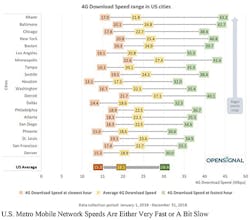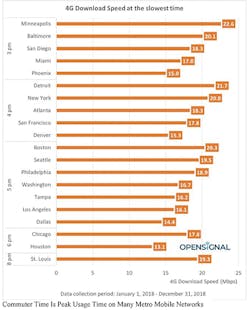Big Swings in 4G Speeds Coupled With Increasing Network Congestion Highlight US Need for 5G
As the mobile industry prepares for Mobile World Congress and much debate about 5G’s future, Opensignal, the independent global standard for measuring real-world mobile network experience, recently released new analysis highlighting 5G’s unsung benefit: the ability to relieve congestion and capacity pressure on the world’s mobile networks. The new report, The 5G Opportunity: How 5G will solve the congestion problems of today’s 4G networks, provides a global comparison of network speeds across 52 countries including the US, and the accompanying U.S. analysis provides more detailed US results, including a review of speed and peak usage in 20 top cities.
US Speeds
The report found that the US falls in the middle of the pack (when compared with the other 76 countries reviewed) on 4G download speed experienced by consumers at the fastest hour of the day.
Furthermore, like the rest of the world, the mobile speeds in the US vary widely throughout the day. The best 4G download speeds in the US were 1.9 times faster in the late hours of the night — when networks are quieter and most users are offline — than during the day and after work hours when networks most need to offer a great experience for their users.
“We think the US will be an interesting worldwide barometer of 5G’s impact on congestion and speed consistency because it holds a mid-level rank amongst global countries for average 4G download speeds, and for its range of speed variation by time of day,” said Brendan Gill, CEO of Opensignal. “It will be one of the first countries to widely adopt 5G services, and any improvements we see in the US mobile consumer experience due to 5G we’ll likely see reflected in many other parts of the world.”
City Speeds
The hour-by-hour fluctuations in download speed also vary by urban locations. At a national level, average 4G download speeds in the US ranged from 15.3 Mbps at the busiest hour — when the most users were consuming the greatest amount of data on the network — to 28.8 Mbps at the quietest hour. However, in the 20 largest cities in the US that range expands in every instance.
InvisiLight® Solution for Deploying Fiber
April 2, 2022Go to Market Faster. Speed up Network Deployment
April 2, 2022Episode 10: Fiber Optic Closure Specs Explained…
April 1, 2022Food for Thought from Our 2022 ICT Visionaries
April 1, 2022Wildly seesawing 4G speeds throughout the day are common in US cities. Over a 24-hour period, consumers in major metro areas will often see their 4G download speeds drop by 20 Mbps or more as demand increases and networks become more congested.
However, when Opensignal compared the speed at the hour of the day when urban users experience the fastest mobile network speeds with the hour where they experience the slowest, it found that almost every urban fastest-hour speed was 10 to 20 Mbps above its average. Meanwhile, slowest-hour speeds across cities were typically only 3 to 5 Mbps below average.
That means that metro 4G networks are likely congested as the average connections are nowhere near the high speeds that networks can support under optimal conditions.
In addition, operators are doing a good job managing the vast number of users awake and using their smartphones at the busiest times in their major markets. Even the speeds at the busiest hours are only a few megabits shy of city averages.
• Miami was the least consistent of the 20 cities analyzed with speeds yo-yoing between 17 Mbps and 43.2 Mbps over the course of a day.
• Baltimore, Chicago, and New York City, also had sizable fluctuations in speed with differences of 20 Mbps or more depending on the time.
• Denver’s optimal-time 4G download speed of 30 Mbps was still nearly double its most-congested-time speed of 15.3 Mbps.
20-City Breakdown
The report also examined the specific hours of the day where 4G download speeds were fastest and slowest in each US city. Their measurements illustrate that the busy times of day vary by city and range from 3 p.m. to 9 p.m.
For the US as a whole, however, the busiest hour falls at 8 p.m., which was the case for only 1 city in our top 20: St. Louis. That means there’s something about living in dense metropolitan areas that causes consumers to load up their networks earlier in the day — around commute time.
The modern-day reality of working in a big city is often a big commute. Whether it’s streaming music or using navigation services while trapped in gridlock on an LA freeway, or catching up on your favorite TV program while riding the L in Chicago, the peak usage hours for these cities tends to fall mainly within the 4-6 p.m. rush-hour period.
Meanwhile, the fastest hour of the day was measured between 3 a.m. to 6 a.m. for all 20 cities. The early morning peak speed simply illustrates that few people are actually awake, and much less data is consumed in the dead of night. This fairly closely mirrors the global picture, where the fastest hours in the countries analyzed were between 2 a.m. and 5 a.m.
Like this Article?
Subscribe to ISE magazine and start receiving your FREE monthly copy today!
Download/view a copy of the report to see the full analysis and charts at: https://opensignal.com//reports-data/global/data-2019-02/Opensignal-The-5G-Opportunity.pdf.
And to learn more about Opensignal, visit www.opensignal.com and check out the following resources:
• January 2019 State of Mobile Networks: USA Report – https://opensignal.com/reports/2019/01/usa/mobile-network-experience
• Understanding Opensignal’s Metrics — https://opensignal.com/blog/2019/01/03/understanding-mobile-network-experience-what-do-opensignals-metrics-mean-2/
• Why Confidence Intervals are Vital — https://opensignal.com/blog/2019/02/13/why-confidence-intervals-are-vital-in-analyzing-mobile-network-experience/
About the Author: Opensignal is an independent global standard for measuring real-world mobile network experiences. For market analysis, their independent reports are the globally recognized standard for understanding the true state of the world’s mobile networks based on measurements of real user experience. For more information, please visit https://www.opensignal.com/.






